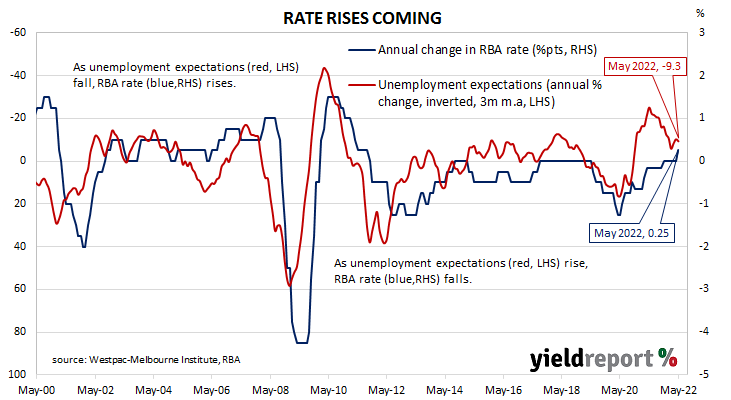Summary: Household sentiment deteriorates for sixth consecutive month in May; rising cost of living pressures, prospect of rising interest rates behind weakness; four of five sub-indices lower; “largest negative reaction” following interest rate rise; respondents more concerned by prospects of unemployment.
After a lengthy divergence between measures of consumer sentiment and business confidence in Australia which began in 2014, confidence readings of the two sectors converged again in mid-July 2018. Both measures then deteriorated gradually in trend terms, with consumer confidence leading the way. Household sentiment fell off a cliff in April 2020 but, after a few months of to-ing and fro-ing, it then staged a full recovery. However, consumer sentiment has deteriorated significantly in recent months, unlike business sentiment.
According to the latest Westpac-Melbourne Institute survey conducted in the first week of May, household sentiment has deteriorated for a sixth consecutive month. Their Consumer Sentiment Index fell from April’s reading of 95.8 to 90.4, a reading which is noticeably lower than the long-term average reading of just over 101.
“The Index is now at its lowest level since August 2020 when households were unnerved by the ‘second wave’ lockdown in Victoria. The weakness in this survey is not related to another pandemic shock but to the combination of rising cost of living pressures and the prospect of rising interest rates,” said Westpac Chief Economist Bill Evans.
Any reading of the Consumer Sentiment Index below 100 indicates the number of consumers who are pessimistic is greater than the number of consumers who are optimistic.
Domestic Treasury bond yields fell on the day. By the close of business, the 3-year ACGB yield had lost 5bps to 3.09%, the 10-year had shed 7bp to 3.54% while the 20-year yield finished 6bps lower at 3.85%.
In the cash futures market, expectations of any material change in the actual cash rate, currently at 0.31%, eased slightly for months from October onwards. At the end of the day, contract prices implied the cash rate would rise to 0.58% in June and then rise to 1.41% by August. May 2023 contracts implied a cash rate of 3.415%, 310bps above the current cash rate.
Four of the five sub-indices registered lower readings, with the “Family finances – next 12 months” sub-index posting the largest monthly percentage loss. The reading of the “Family finances versus a year ago” sub-index was the only one to increase.
“This was the largest negative reaction that has followed an increase in official interest rates,” said Citi economist Josh Williamson. “Rising cost of living pressures likely also added to the negative sentiment but we believe it is also evidence that households could be more sensitive to higher interest rates during the upcoming tightening cycle.” He said rate previous rate rise cycles had begun when the sentiment index had been in positive territory but he also noted current monetary policy was “still highly accommodative.”
The Unemployment Expectations index, formerly a useful guide to RBA rate changes, rose from 99.2 to 109.6. Higher readings result from more respondents expecting a higher unemployment rate in the year ahead.



